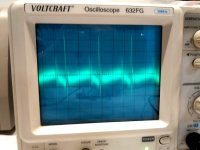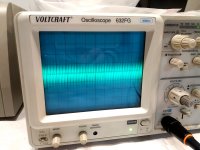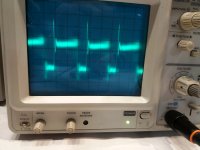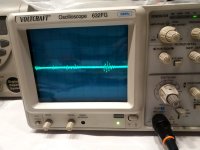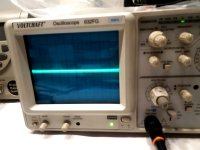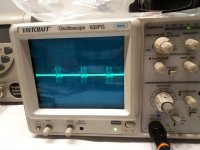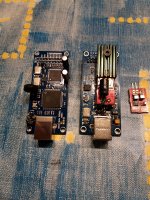I have chance to try new 3pin lt3045 regulators from Aleš in various positions in building another ak4495 dac.
This regs are excellent... easy to implement and nice sounding. My scope could not measure noise compared to reference gnd pin.
I use mixture of both regulators Tps7a4700 and lt3042/45. I have tried lt3042 on all positions and sound is maybe maybe little to slow (excellent for harsh, overhyped Sabre dacs)... but is full, good transparency, sweet, although on the other side Tps7a4700 is little more dynamic but little harsh, not so controlled, like a wild dog, after let him from appartment 🙂 so you must choose right combination for your gear.
Today I made 1V regulator for xmos usb card.This core supply pin is very important for xmos U8 performance. At last dac that i made it with average NPC regulator (no 1V TPS7A4700 reg exist), but it was hard because of heat dissipation and small experimental board. But it was worth. Sound is more liquid, less harsh, more dynamic, more analog sounded.
With Aleš 3 pin regulator it was simple and see the result... excellent.
First 3 pictures 1V supply pin, 3,3V supply pin and 5V supply pin original design modified with some caps improvement.
second 3 pictures same position with Lt3045 installed. Supply was with batteries. I modified boards that now i have jumpers to choose between usb supply and external supply.
Thank you Aleš for your excellent work!!!
This regs are excellent... easy to implement and nice sounding. My scope could not measure noise compared to reference gnd pin.
I use mixture of both regulators Tps7a4700 and lt3042/45. I have tried lt3042 on all positions and sound is maybe maybe little to slow (excellent for harsh, overhyped Sabre dacs)... but is full, good transparency, sweet, although on the other side Tps7a4700 is little more dynamic but little harsh, not so controlled, like a wild dog, after let him from appartment 🙂 so you must choose right combination for your gear.
Today I made 1V regulator for xmos usb card.This core supply pin is very important for xmos U8 performance. At last dac that i made it with average NPC regulator (no 1V TPS7A4700 reg exist), but it was hard because of heat dissipation and small experimental board. But it was worth. Sound is more liquid, less harsh, more dynamic, more analog sounded.
With Aleš 3 pin regulator it was simple and see the result... excellent.
First 3 pictures 1V supply pin, 3,3V supply pin and 5V supply pin original design modified with some caps improvement.
second 3 pictures same position with Lt3045 installed. Supply was with batteries. I modified boards that now i have jumpers to choose between usb supply and external supply.
Thank you Aleš for your excellent work!!!
Attachments
Hi Ales. Are you still selling the single TPS7A4700LPS board? Is for one 12v DDDAC.
If yes .. whats traffo do you recommend for 12V DC out?
Thanks a lot!
If yes .. whats traffo do you recommend for 12V DC out?
Thanks a lot!
@Aleš
I'm very interested in the new 6x LT3045 high current output 3A board to use with a RPI and Kali Re-clocker.
Can you please tell me if they are ready yet?
Thanks.
I'm very interested in the new 6x LT3045 high current output 3A board to use with a RPI and Kali Re-clocker.
Can you please tell me if they are ready yet?
Thanks.
@Aleš
I'm very interested in the new 6x LT3045 high current output 3A board to use with a RPI and Kali Re-clocker.
Can you please tell me if they are ready yet?
Thanks.
PM Sent!
bregards,
Aleš
Dual LT3042
Ales
I need +/- 5v PS for a DAC. Can your dual LT3042 board be powered with DC and if so what voltage would be required?
Ales
I need +/- 5v PS for a DAC. Can your dual LT3042 board be powered with DC and if so what voltage would be required?
Ales
I need +/- 5v PS for a DAC. Can your dual LT3042 board be powered with DC and if so what voltage would be required?
Hi Studley,
yes, these boards can be powered with DC voltage, 6V DC will be enough. However, for symmetrical voltage you need two galvanical isolated DC voltages.
BR,
Aleš
Hi Studley,
yes, these boards can be powered with DC voltage, 6V DC will be enough. However, for symmetrical voltage you need two galvanical isolated DC voltages.
BR,
Aleš
Ok. I was thinking of using a bench supply that can simultaneously output 3 separate DC voltages. Would using 2 of those work?
I think it should do the trick. You can also check with DMM if there is any connection between the outputs.
BR,
Aleš
BR,
Aleš
I think it should do the trick. You can also check with DMM if there is any connection between the outputs.
BR,
Aleš
Ok. Alternatively, would one transformer with 2 sets of secondary outputs work, or would I need 2 separate transformers? And what voltage should the secondaries be?
Yes, transformer with two secondary outputs is the way. Also make sure it is not center tapped transformer. Ideally AC voltage should be 6.5V rated at 10VA.
The old LT1764 PSUs were replaced, using paralleled LT3045 boards from Ales both in my 9038PRO DAC (4x 3.3V/1A) and in my single board Unix computer (1x 5V/3A).
The AC parts of the old PSUs were kept, as the Cree silicon carbide diodes and the Black Gate Electron Transfer caps produced better sound than the standard thru-hole components camed with the package. SMD components of the Ales' boards were not replaced in this phase.
I'm very pleased with the result. The new regulator seems even better than the Diyinhk LT3042 board. Which is not a surprice, as Diyinhk board uses single LT3042 0.2A chip on their board plus addtional component to produce a nominal 1.5A power. Paralleling both teoretically and in practice performs better.
The AC parts of the old PSUs were kept, as the Cree silicon carbide diodes and the Black Gate Electron Transfer caps produced better sound than the standard thru-hole components camed with the package. SMD components of the Ales' boards were not replaced in this phase.
I'm very pleased with the result. The new regulator seems even better than the Diyinhk LT3042 board. Which is not a surprice, as Diyinhk board uses single LT3042 0.2A chip on their board plus addtional component to produce a nominal 1.5A power. Paralleling both teoretically and in practice performs better.
Hi Abra,
thank you for your feedback. Any chance to post a photo of your project?
Regards,
Aleš
thank you for your feedback. Any chance to post a photo of your project?
Regards,
Aleš
Dear Mravica,
Do you have any of there boards available ?
One more question: what diodes are provided with the boards ? I have two of them, but I was not sure of their identification.
Thanks,
Davide
Do you have any of there boards available ?
One more question: what diodes are provided with the boards ? I have two of them, but I was not sure of their identification.
Thanks,
Davide
Sorry to inform. At the moment he do work that brings him better life for less working time. He spent really really much time and effort to give us his excellent designes. Thank you. Maybe he will be back. But i doub*t.
In case some of you are interested in a scalable regulator which is able to handle low and high currents.
Finally, an affordable CD Transport: the Shigaclone story
Regards,
Tibi
Finally, an affordable CD Transport: the Shigaclone story
Regards,
Tibi
- Home
- Vendor's Bazaar
- TPS7A4700 low noise LDO regulator PCB
